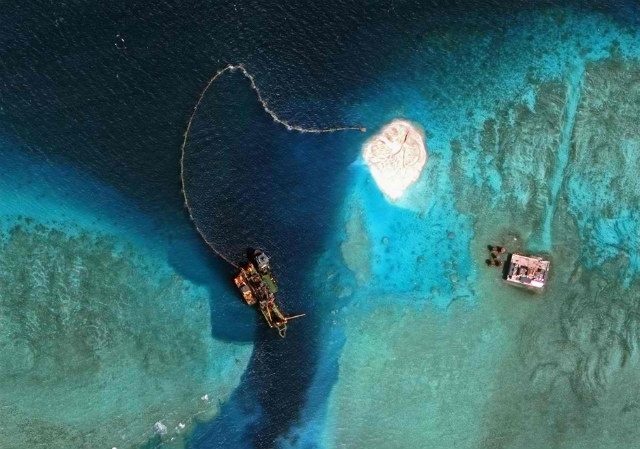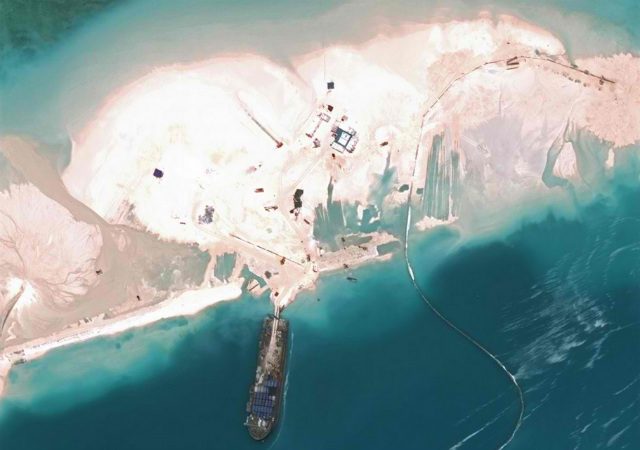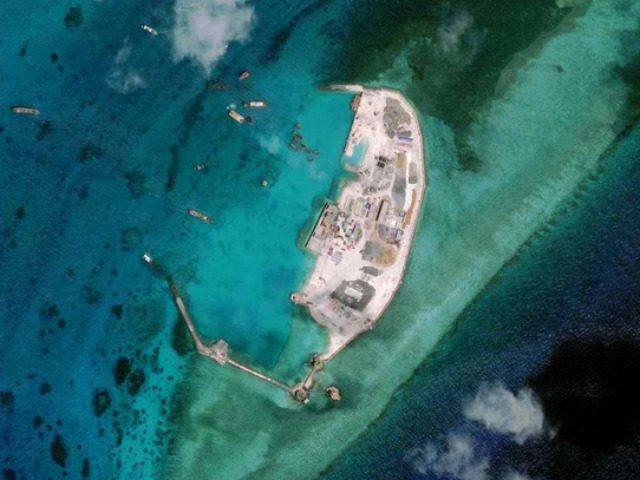SUMMARY
This is AI generated summarization, which may have errors. For context, always refer to the full article.

MANILA, Philippines – Vietnam on Wednesday, May 14, defended its construction activities in the disputed South China Sea as shown in recently published satellite images.
In an e-mail to Rappler, Vietnamese Ambassador to the Philippines Truong Trieu Duong said, “Activities conducted by Vietnam as you mentioned are wholly aimed at improving the old physical facilities in order to serve the minimum daily needs of the people living in islands which are under the jurisdiction of Vietnam in the Spratlys.”
These activities, which Rappler mentioned in an earlier e-mail to Duong, involve the construction reported by the Washington-based Center for Strategic and International Studies (CSIS) on May 7.
Using satellite imagery, the CSIS’ Asia Maritime Transparency Initiative said it confirmed that Vietnam “has engaged in land reclamation in recent years” on Sand Cay and West Reef, two features in the Spratly Islands in the South China Sea.
The CSIS said these satellite images reveal the following:
- “That in the last several years, Vietnam has added approximately 65,000 square meters to West Reef and 21,000 square meters to Sand Cay. It has also developed its military facilities at Sand Cay.”
- “By comparison, in the last year, China has reclaimed 7 features. Its largest Spratly project is Fiery Cross Reef, whose landmass may exceed 900,000 square meters.”
- “According to US government officials, China has now reclaimed over 2 million square meters of new land, while Vietnam’s reclamation projects total approximately 200,000 square meters.”
Duong pointed out that the CSIS report “is not totally accurate.” He didn’t describe their construction activities as “land reclamation” as the CSIS did.
“In fact, Vietnam has several times embellished some of the islands which are under its jurisdiction, but in a very small scale, mostly constructing ridges against shoreline erosion; building a dock and wharf; (and providing) logistics for fishing services. Our construction and embellishment do not change the status quo,” the ambassador said.
The Philippines’ Department of Foreign Affairs (DFA) on Monday, May 11, said it was verifying Vietnam’s reported land reclamation.
The CSIS report came as the Philippines protests China’s reclamation activities in the South China Sea and, at the same time, seeks a stronger alliance with Vietnam in the face of an aggressive China.

‘Indisputable sovereignty’
Responding to Rappler’s questions, the Vietnamese ambassador pointed out that his country’s construction in the South China Sea is unlike China’s activities.
For one, Duong said, “Vietnam has indisputable sovereignty over the Paracel and Spratly archipelagos.”
Because of this, he said Vietnam’s activities in Spratly and Paracel Islands in the South China Sea “are completely legitimate and normal.”
Vietnam, he added, pursued these “in accordance with the Declaration on the Conduct (DOC) of Parties in the South China Sea,” a 2002 statement that aims to prevent tension and ensure maritime security.
In line with the DOC, Vietnam’s activities “neither change the status quo nor further complicate the current territorial disputes.”
Duong said: “Vietnam has resolutely expressed its opposition to all acts violating the sovereignty, sovereign rights, and jurisdiction of Vietnam in the South China Sea. It also requests all parties concerned to exercise restraint, without altering the status quo, destroying the marine environment, threatening peace, stability, freedom of navigation, and aviation in the region.”
He added that Vietnam has “repeatedly requested all parties concerned to comply fully with the DOC and the relevant provisions of international law, particularly the United Nations Convention on the Law of the Sea in 1982,” the so-called “Constitution for the Oceans.”

‘Contrary to Vietnam’s normal activities’
Duong explained why Vietnam’s activities shouldn’t be compared to China’s “‘artificial islands’ strategy.”
“China, contrary to Vietnam’s normal activities, is building up rocky areas, changing underwater reefs into islands, and building runways and infrastructure on illegally occupied islands,” he said.
The ambassador added: “Such activities will have serious impact that will change the geographical status quo, affect marine environment in the South China Sea. The scale and purposes of China’s activities are totally different from what Vietnam is doing on its islands.”
The Philippines’ Bureau of Fisheries and Aquatic Resources earlier said China’s reclamation has buried 311 hectares of coral reefs, or 5 times the size of Rizal Park in Manila. (READ: China reclamation poses P4.8-B economic loss for PH)
Reports on Vietnam’s construction activities come as the Philippines and Vietnam try to forge a strategic partnership, which is expected to boost the two countries’ security alliance. (READ: Can the Philippines and Vietnam be strategic partners?)
Vietnam is also helping the Philippines on the legal front. On December 11, 2014, Vietnam filed a position paper to support the Philippines’ case against China before an arbitral tribunal at the Permanent Court of Arbitration based in The Hague, The Netherlands. (READ: PH to tribunal: Vietnam boosts case vs China)
In May 2014, Duong said in an interview with Rappler that the Philippines and Vietnam should “stand united.” He said, “We are on the same side.”
He also said that to keep peace and stability in the South China Sea, the Philippines and Vietnam can share marine resources in the disputed waters. He said the same idea, however, will not work with China because the Asian giant “is claiming the whole sea.” – Rappler.com
Add a comment
How does this make you feel?
There are no comments yet. Add your comment to start the conversation.